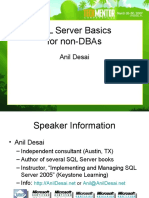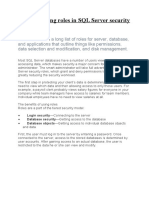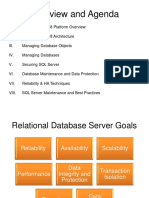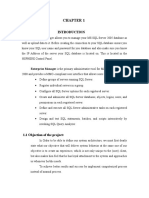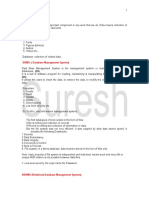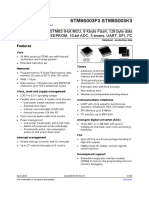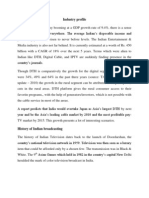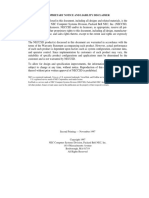02 Configuring SQL Server
Uploaded by
Brian Miller02 Configuring SQL Server
Uploaded by
Brian MillerData Files
There are two kinds of files associated with SQL Server, data files and log files. The log files contain the transaction log, usually the ldf extension. There are two kinds of data files, primary and secondary. Primary Mandatory and contains the startup information for the database catalog, and points to other database files. The common extension for the primary data file is mdf. Secondary Optional and user-defined. You can put each data file on a different disk drive. A database can contain at most 32,766 secondary data files. The common extension for this data file is .ndf
Filegroups
A filegroup is a logical structure that allows DBAs to group data files and manage them as a logical unit. This allows you to split database objects across data drives so that disk operations can be done in parallel. Filegroups can only contain data files! There are two types of filegroups: Primary Contains all system tables and primary files. User defined Group secondary files and assign database objects. Can contain up to 32,766 user defined file groups. Configuring Filegroups Each database has a default filegroup, and every database object is assigned to the default filegroup by default. You can configure a filegroup as read-only. The default file group cannot be configured as readonly. The filegroup can be specified when using the CREATE DATABASE command, and the ALTER DATABASE command can configure an existing item. Filegroup properties Name Filename full filename and path. Size Maxsize you can use the UNLIMITED keyword which will allow the group to grow until the disk is full. Filegrowth
Filegroup Example: CREATE DATABASE Records ON PRIMARY ( NAME = RecordsPrimary, FILENAME = d:\SQLData\RecordsPrimaryFile.mdf SIZE = 100MB, MAXSIZE=200, FILEGROWTH=20 ), FILEGROUP RecordsFG ( NAME = RecordsData1, FILENAME = e:\SQLData\RecordsPrimaryFile.ndf SIZE = 100MB, MAXSIZE=200, FILEGROWTH=20 ), ALTER DATABASE Records ADD FILE ( NAME = RecordsData2, FILENAME = e:\SQLData\RecordsData2.ndf, SIZE = 100MB, MAXSIZE = 500MB, FILEGROWTH = 75MB ) TO FILEGROUP RecordsFG
Raid System
Types:
RAID 0 (disk striping) Does not provide fault tolerance. Gives the best read and write performance. If a disk fails you lose access to all data on the stripe set. RAID 1 (disk mirroring) provides redundant copy of the selected disk. Read access is better than RAID 0, but writing is not. RAID 5 Stripes all the data, and adds parity information and provides better performance than RAID 1. RAID 10 Includes both striping (without parity) and mirroring, this allows for better performance than RAID 5.
Configuring Database Mail
Database mail is not enabled by default. It must be enabled by using the SQL Server Surface Area Configuration, or the sp_configure procedure. The Service Broker needs to be enabled for the host database. By default it is enabled for the msdb. The SQL Server service account needs access to the SMTP server in terms of authentication.
Database Mail Architecture Configuration components o Database Mail Account Contains information such as the SMTP server name, the authentication type, and the email address. o Database Mail profile Contains a collection of database mail accounts. Allows DBAs to change information w/o modifying the application. Messaging components The main component is the host database, which contains all the DB Mail objects. The DB Mail host is msdb. DB Mail executable The db mail application is DatabaseMail90.exe, located in MSSQL\Binn. DB Mail uses the Service Broker to start the application when e-mail messages are waiting. Logging/Auditing DB Mail stores log information in tables in the host database. You can see this information by quering the sysmail_event_log system view. Configuring DB Mail Stored Procedures: o msdb.sysmail_add_account_sp o msdb.sysmail_add_profile_sp o msdb.sysmail_add_profileaccount_sp o msdb.sysmail_add_principalprofile_sp
Specifying a Recovery Model
Recovery Models Full Recovery Model o All operations are logged to the transaction log. o The transaction log is never truncated. o Allows the database to be restored to the point of failure. Simple Recovery Model o Minimally logs most operations to the transaction log. o Truncates the log after each checkpoint. The transaction log cannot be backed up or restored. Bulk-Logged recovery model o Minimally logs bulk operations such as SELECT INTO and BULK INSERT. o Allows you to restore the database to the end of a log backup. How to Configure Recovery Models Determine the recovery model. SELECT name, recovery_model_desc from sys.databases Change the recovery mode: o Properties | Options | Recovery model. o ALTER DATABASE <databasename> SET RECOVERY FULL | SIMPLE | BULK_LOGGED
Configuring Server Security Principals
Authentication Modes Windows Authentication Each user or group needs to be given access. Mixed Mode Uses both Windows Authentication and SQL users. Configure Logins To specify the authentication mode: Server | Properties | Security. To create a windows login: CREATE LOGIN [Domain\User] FROM WINDOWS To create a SQL Server login: CREATE LOGIN loginname WITH PASSWORD=pass Options to be configured with a login: MUST_CHANGE CHECK_EXPIRATION CHECK_POLICY- SQL Server will apply the local Windows password policy on the SQL Server logins. Examples:
CREATE LOGIN mylogin WITH PASSWORD =pass123 , CHECK_EXPIRATION=ON, CHECK_POLICY=ON ALTER LOGIN mylogin DISABLE DROP LOGIN mylogin
Fixed Server Roles Sysadmin full administrator. Serveradmin Configure server-wide settings. Setupadmin Add/remove linked servers and execute some stored procedures. Securityadmin Manage server logins. Processadmin Manage processes relating to SQL Server. Dbcreator Create and alter databases. Diskadmin - manage disk files. Bulkadmin Execute the BULK INSERT statement. The statement to add a login to a fixed server role: EXECUTE sp_addsvrrolememeber login_name, fixed_server_role.
Configuring Database Securables
After a user has been created, they need to be given access to the database. That can be done with the following command: CREATE USER user_name FOR LOGIN loginname You can allow guest users to get access and remove access by doing the following: GRANT CONNECT TO guest REVOKE CONNECT TO guest Orphaned Users Orphaned users are db users that do not have a login to SQL Server. This can happen if a database user has had their login dropped. You can get a list of orphaned users by executing the following: USE theDatabase; GO Execute sp_change_user_login @Action=report; Database Roles to handle DB Permissions There are a set of standard db roles that can be associated with db users, so that it is easier to handle DB Permissions. Some standard roles are: db_datareader, db_datawriter, db_owner,db_ddladmin. A role can be created using the command: CREATE ROLE role_name You can associate a user to a role by the command: EXECUTE sp_addrolemember role_name, user_name
Managing Schemas Each schema is owned by a user or role, if a user or role is dropped, schema ownership will need to be transferred to another user or role. How to create a schema: CREATE SCHEMA myschema_name AUTHORIZATION user_owner
Configuring Encryption
SQL Server uses a service master key to encrypt Linked server passwords, connection strings, account credentials, and all database master keys. You can backup the service master key by doing the following: BACKUP SERVICE MASTER KEY TO FILE=filepath ENCRYPTION BY PASSWORD = password RESTORE SERVICE MASTER KEY FROM FILE=filepath DECRYPTION BY PASSWORD= password Regenerate the key by: ALTER SERVICE MASTER KEY REGENERATE You can create a database master key, which is a symmetric key at the database level. You can create a database key by doing the following: CREATE MASTER KEY ENCRYPTION BY PASSWORD=pass You can create a symmetric key by doing the following: CREATE SYMMETRIC KEY key_name WITH ALGORITHM = AES_256 ENCRYPTION BY PASSWORD = pass Use the EncryptByKey and DecryptByKey methods to encrypt data. To create an asymmetric key: CREATE ASYMMETRIC KEY key_name WITH ALGORITHM = RSA_2048 ENCRYPTION BY PASSWORD = pass Configure Certificates How to create a certificate: CREATE CERTIFICATE cert_name WITH SUBJECT = certificate_subject How to encrypt data from a certificate: CREATE CERTIFICATE testCERT WITH SUBJECT = Certificate for testing GO SELECT Title, EncryptbyCert( Cert_id(testCERT), Title)Title_Encrypted from MyTable
You might also like
- SQL Server DBA Interview Questions and Answers100% (3)SQL Server DBA Interview Questions and Answers10 pages
- SQL Server Security (Logins, Users - Fixed Roles)No ratings yetSQL Server Security (Logins, Users - Fixed Roles)3 pages
- 1) How Many Types of Files Are There in A SQL Server Database?No ratings yet1) How Many Types of Files Are There in A SQL Server Database?16 pages
- Microsoft SQL Server 2008 AdministrationNo ratings yetMicrosoft SQL Server 2008 Administration122 pages
- Microsoft SQL Server Administration Using MS SQL Server 2008No ratings yetMicrosoft SQL Server Administration Using MS SQL Server 2008122 pages
- Database Administration: Create and Manage Database User Accounts Chapter 8 (OCA Oracle Exam Book)No ratings yetDatabase Administration: Create and Manage Database User Accounts Chapter 8 (OCA Oracle Exam Book)32 pages
- MS SQL Server Is A Relational Database Management SystemNo ratings yetMS SQL Server Is A Relational Database Management System125 pages
- SQL Server DBA Interview Questions and AnswersNo ratings yetSQL Server DBA Interview Questions and Answers10 pages
- System Administration Accounts Privileges, Users and RolesNo ratings yetSystem Administration Accounts Privileges, Users and Roles31 pages
- Data Files and Database Options: Unit OneNo ratings yetData Files and Database Options: Unit One68 pages
- SQL Server Security Database and OS Level AuditNo ratings yetSQL Server Security Database and OS Level Audit19 pages
- Home Work: #1 Int401: Database Administration: Section: DE532No ratings yetHome Work: #1 Int401: Database Administration: Section: DE5326 pages
- Securing Databases & T-SQL For Data Control: Hanoi University of TechnologyNo ratings yetSecuring Databases & T-SQL For Data Control: Hanoi University of Technology84 pages
- 1.4 MS SQL Server (Database and Schema) - Section - 2No ratings yet1.4 MS SQL Server (Database and Schema) - Section - 244 pages
- Quick Configuration of Openldap and Kerberos in Linux and Authenicating Linux to Active DirectoryFrom EverandQuick Configuration of Openldap and Kerberos in Linux and Authenicating Linux to Active DirectoryNo ratings yet
- Site To Site VPN Using DHCP Over VPN SonicOS Enhanced atNo ratings yetSite To Site VPN Using DHCP Over VPN SonicOS Enhanced at9 pages
- Chapter 2 Communicating Over The NetworkNo ratings yetChapter 2 Communicating Over The Network34 pages
- Desktop Publishing: An Introduction: Chapter-1No ratings yetDesktop Publishing: An Introduction: Chapter-113 pages
- Traffic Case Description - Mobile Originating Calls100% (3)Traffic Case Description - Mobile Originating Calls13 pages
- IEI PXAGP 13S3 (R) Datasheet1 1153846873 PDFNo ratings yetIEI PXAGP 13S3 (R) Datasheet1 1153846873 PDF1 page
- Service Manual - NEC Versa 2700 Series Laptop PDFNo ratings yetService Manual - NEC Versa 2700 Series Laptop PDF130 pages









